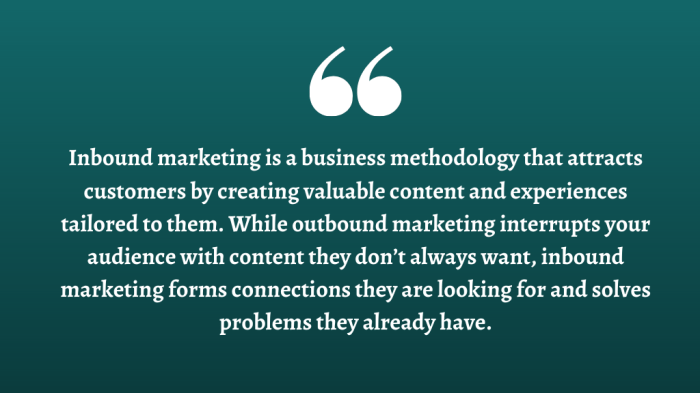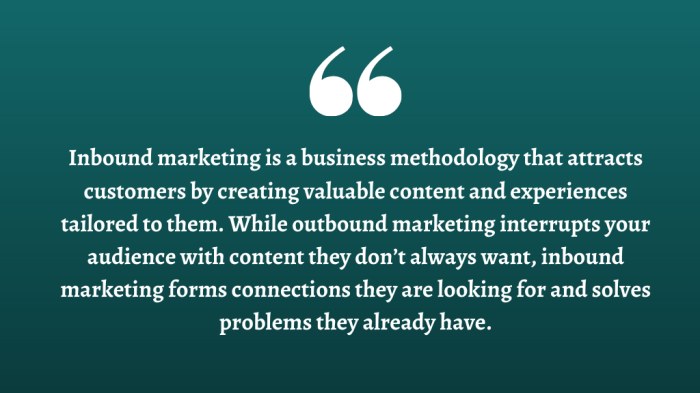Five key things to know about inbound marketing: This guide delves into the core principles of inbound marketing, highlighting its five crucial elements and how they work together to attract and engage customers. We’ll explore defining inbound, understanding its key aspects, content strategy, visitor attraction, measurement, and real-world examples, equipping you with a solid foundation for success.
Inbound marketing, in contrast to traditional outbound methods, focuses on attracting customers through valuable content and experiences. It’s about drawing them in rather than interrupting them, nurturing relationships, and ultimately, driving conversions. This approach emphasizes building trust and loyalty, leading to long-term growth and brand advocacy.
Defining Inbound Marketing
Inbound marketing is a strategic approach to attracting and engaging customers online. It focuses on creating valuable content and experiences that draw prospects in rather than interrupting them with traditional advertising. This method fosters a long-term relationship with customers by providing them with relevant information and solutions, leading to increased brand loyalty and conversions.Inbound marketing stands in stark contrast to outbound marketing, which often involves interrupting potential customers with advertisements.
Instead of pushing products or services, inbound marketing pulls customers in through valuable content, such as blog posts, videos, and social media updates. This creates a more natural and engaging interaction with potential clients.
Core Principles of Inbound Marketing
Inbound marketing is built upon several core principles that differentiate it from outbound marketing. These principles emphasize attracting customers through valuable content and experiences. Attracting customers involves creating content that is tailored to their needs and interests. Engaging customers with interactive experiences encourages interaction and deeper understanding. Delighting customers with personalized solutions and follow-up demonstrates commitment and value.
Inbound Marketing vs. Outbound Marketing
The table below highlights the key differences between inbound and outbound marketing approaches.
| Feature | Inbound Marketing | Outbound Marketing |
|---|---|---|
| Focus | Attracting customers through valuable content and experiences. | Interruption-based advertising to reach a broad audience. |
| Customer Interaction | Creates opportunities for two-way communication and engagement. | One-way communication; customers are passive recipients of messages. |
| Content Strategy | Focuses on creating valuable content tailored to customer needs. | Focuses on promoting products or services through various channels. |
| Customer Journey | Guides customers through the sales funnel using helpful content. | Interrupts the customer journey with advertising messages. |
| Cost | Generally more cost-effective in the long run. | Can be expensive, especially for large-scale campaigns. |
| Measurability | Provides clear metrics to track the effectiveness of campaigns. | Difficult to measure the precise impact of individual campaigns. |
Historical Context of Inbound Marketing
The evolution of inbound marketing mirrors the rise of the internet and digital technologies. Early forms of inbound marketing existed in the form of content marketing and online communities, but the modern approach has gained prominence with the increased use of search engines, social media, and other digital channels. The internet’s influence on customer behavior has made it crucial for businesses to adapt their marketing strategies.
Inbound marketing is all about attracting customers, and one crucial aspect is understanding your audience. Knowing your target demographic helps you tailor your content effectively. A key part of this is building a strong email list, which is where email marketing comes in. Strategies like segmenting your email lists and personalizing your messages can greatly boost sales.
For instance, check out how to maximize ecommerce store sales using email marketing here. Ultimately, understanding your customers and providing valuable content are fundamental principles in inbound marketing.
Key Goals and Objectives of Inbound Marketing Strategies
Inbound marketing strategies aim to achieve specific goals and objectives. These goals include driving organic traffic to websites, generating leads, nurturing those leads into customers, and ultimately boosting revenue. By focusing on these key objectives, inbound marketing campaigns strive to create a sustainable and profitable customer base. A successful inbound marketing strategy should attract the right audience, and then engage with them through valuable content.
Understanding the Five Key Aspects
Inbound marketing isn’t just about creating great content; it’s about a strategic approach that attracts, engages, and converts prospects into customers. To truly grasp its power, we need to dissect the five fundamental pillars that underpin this methodology. These pillars aren’t isolated components but rather interconnected elements that work in harmony to create a powerful and sustainable marketing machine.Understanding these five crucial elements allows marketers to tailor their strategies effectively, leading to improved ROI and a more effective use of resources.
These elements aren’t just theoretical concepts; they’re actionable steps that can be implemented in real-world marketing campaigns.
The Five Pillars of Inbound Marketing
Inbound marketing isn’t a one-size-fits-all approach. It’s a dynamic strategy that adapts to specific business needs and objectives. To achieve a successful inbound strategy, a deep understanding of the five fundamental elements is crucial. These elements, when used in synergy, form the foundation of a powerful marketing strategy.
| Element | Description | Importance |
|---|---|---|
| Attract | This involves creating valuable content that resonates with your target audience. This could include blog posts, articles, infographics, videos, podcasts, and more. The goal is to proactively reach potential customers by providing valuable information that addresses their needs and pain points. | Attracting the right audience is the first step in the inbound journey. High-quality content draws in interested prospects and establishes your brand as a thought leader in the industry. |
| Engage | Once you’ve attracted visitors, the next crucial step is to keep them engaged. This involves providing valuable resources and interactions that encourage further exploration of your website and brand. Examples include interactive quizzes, lead magnets, webinars, email newsletters, and social media engagement. | Engaging visitors fosters trust and builds relationships. By providing relevant content and experiences, you keep visitors coming back for more, increasing the likelihood of conversion. |
| Convert | Conversion is the pivotal point where leads transition from visitors to qualified prospects. This involves strategically using forms, calls to action (CTAs), and other lead generation tools to capture the contact information of interested parties. Lead scoring and nurturing are also crucial to effectively converting visitors. | Conversion marks the transition from passive visitors to active prospects. By implementing effective conversion strategies, you can ensure you’re collecting the right information from the right people. |
| Delight | Delighting customers goes beyond just meeting their initial needs. It involves providing exceptional service and support throughout the customer journey. This includes offering helpful resources, responsive customer service, and follow-up communication. This is where you build loyalty and advocacy. | Delighting customers cultivates long-term relationships. Satisfied customers become brand advocates, driving referrals and positive word-of-mouth marketing. |
| Analyze | Data analysis is critical to understanding what’s working and what’s not. Using analytics tools, you can track key metrics such as website traffic, lead generation, conversion rates, and customer behavior. This allows you to make data-driven decisions to optimize your inbound strategy and maximize results. | Analysis is the engine of continuous improvement. By understanding what’s working and what’s not, you can adapt and refine your inbound marketing efforts to maximize their impact and ROI. |
Interconnectedness of the Five Elements, Five key things to know about inbound marketing
The five elements of inbound marketing are not isolated silos. They are interconnected and interdependent. Attracting visitors is meaningless without the ability to engage them effectively, and engaging them is futile if there’s no way to convert them into leads. Delightful customer experiences are built upon strong conversion strategies, and effective analysis is critical to refining and optimizing every step of the process.
In essence, each element feeds into and supports the others, creating a powerful and sustainable marketing cycle.
Content Strategy for Inbound Marketing: Five Key Things To Know About Inbound Marketing
High-quality content is the lifeblood of any successful inbound marketing strategy. It’s the magnet that attracts potential customers, nurtures leads, and ultimately drives conversions. A well-defined content strategy ensures your efforts aren’t scattered but focused on providing value and building relationships. This section dives deep into the importance of content, its diverse forms, and how to craft a strategy that resonates with your target audience.Attracting and engaging your audience requires more than just putting words on a page.
It demands a deep understanding of their needs, pain points, and desires. High-quality content, carefully tailored to these insights, becomes the key to unlocking a loyal customer base. This strategy fosters trust, establishes authority, and ultimately converts prospects into paying customers.
Inbound marketing is all about attracting customers, and a key part of that is understanding how to use social media effectively. For example, hotels can significantly boost their bookings through targeted social media campaigns, like those discussed in depth on this excellent resource about social media marketing hotels. Ultimately, knowing your audience and crafting engaging content are still the cornerstones of any successful inbound marketing strategy.
These five key things are essential to building a strong online presence.
Content Formats for Inbound Marketing
Inbound marketing relies on various content formats to engage audiences at different stages of their journey. Each format serves a unique purpose, contributing to a comprehensive approach. Different content formats are suitable for different stages in the buyer’s journey, each with its own unique purpose.
So, you’re diving into inbound marketing? Knowing the five key things is crucial, but understanding the broader context is key too. One big hurdle for B2B marketers is navigating the complexities of top challenges in b2b marketing. However, if you master the core inbound principles – like creating valuable content, attracting visitors, converting leads, and nurturing them – you’ll be well-positioned to overcome those hurdles and ultimately see great results.
This approach, built on trust and engagement, is far more effective than traditional methods.
- Blog posts are a cornerstone of inbound marketing. They provide valuable information, establishing your brand as a thought leader. Well-researched and engaging blog posts offer a wealth of knowledge, helping your audience find solutions to their problems and solidifying your expertise in the industry.
- Videos are another potent tool. They can convey complex information in an easily digestible format, especially for visual learners. They can include interviews, product demonstrations, or behind-the-scenes looks at your business, making the content more personal and engaging. Explainer videos and product tutorials are excellent examples.
- Infographics present data in a visually appealing way, making it easier for audiences to grasp complex information quickly. Infographics are ideal for showcasing statistics, trends, or comparisons. They’re particularly useful when you need to quickly communicate key insights.
- Case studies showcase the real-world impact of your products or services. They provide social proof, demonstrating how your offerings have benefited other customers. They are a powerful way to build trust and credibility.
- Ebooks and white papers offer in-depth information on a specific topic, positioning you as an expert. They often address complex issues and provide valuable insights to the audience, providing actionable strategies.
Buyer’s Journey and Content Alignment
Understanding the buyer’s journey is crucial for aligning your content with the needs of your target audience at each stage. The table below illustrates different content formats tailored to each stage of the buyer’s journey.
| Stage of the Buyer’s Journey | Suitable Content Formats |
|---|---|
| Awareness | Blog posts, social media updates, infographics, videos |
| Consideration | Case studies, white papers, ebooks, webinars, product demos |
| Decision | Testimonials, customer reviews, pricing guides, product comparisons, personalized emails |
| Loyalty | Exclusive content, community forums, surveys, feedback requests, customer success stories |
Consistent Content Creation
Maintaining consistent content creation is essential for maintaining engagement. Regular updates keep your audience coming back for more, driving traffic and fostering loyalty. A consistent content calendar ensures your efforts remain focused and effective.
Content Optimization
Optimizing your content for search engines () and social media platforms is vital for maximizing reach. strategies focus on using relevant s to improve search engine rankings. Effective social media optimization leverages relevant hashtags and formats to increase visibility. By incorporating both strategies, you can maximize the impact of your content across various channels.
Attracting and Engaging Visitors

Inbound marketing isn’t just about creating great content; it’s about attracting the right people to that content. This crucial stage focuses on drawing in potential customers who are actively searching for solutions related to your products or services. Effective strategies in this area lead to higher website traffic, more qualified leads, and ultimately, a stronger return on investment (ROI).Attracting visitors hinges on understanding their needs and pain points.
Knowing what they’re looking for allows you to tailor your content and strategies to resonate with them. This process requires ongoing analysis and adaptation, as customer interests and search patterns evolve.
Effective Strategies for Attracting Visitors
A successful inbound strategy utilizes a blend of tactics to draw in the ideal audience. These strategies are not isolated events but rather interconnected elements of a comprehensive approach.
- Search Engine Optimization (): Optimizing website content and structure for search engines is paramount. This involves research, on-page optimization (like meta descriptions and title tags), and off-page optimization (building backlinks from reputable websites). High search engine rankings place your content before potential customers actively searching for solutions. For example, a plumbing company optimizing for “leaky faucet repair near me” will appear higher in local search results, attracting potential customers.
- Content Marketing: Creating valuable, relevant, and consistent content is fundamental. Blog posts, articles, infographics, videos, and webinars position you as an expert and attract visitors seeking information. A software company publishing insightful articles on project management methodologies will attract professionals in the field.
- Social Media Marketing: Engaging on social media platforms like LinkedIn, Twitter, and Instagram allows you to connect with potential customers, share valuable content, and build brand awareness. A B2B company using LinkedIn to share industry insights and case studies builds credibility and attracts potential clients.
Inbound Marketing Tools for Lead Generation
Implementing the right tools enhances your lead generation efforts. These tools can automate tasks, track progress, and provide valuable insights.
- Lead Magnets: Offering valuable resources like ebooks, templates, or checklists in exchange for contact information attracts potential customers. These incentives provide a direct benefit to the user while simultaneously collecting valuable data.
- Landing Pages: Dedicated landing pages optimized for specific offers and campaigns are crucial for converting visitors into leads. They provide a clear call to action and funnel visitors to the desired outcome. A SaaS company creating a landing page specifically for their new cloud storage service will streamline the lead capture process.
- Forms and Pop-ups: Strategic forms and pop-ups on your website capture visitor information without being intrusive. They effectively collect contact information while ensuring a positive user experience.
Capturing and Nurturing Leads
Once you’ve attracted visitors, capturing and nurturing them is critical for conversion. This stage focuses on building relationships and guiding leads through the sales funnel.
- Lead Scoring and Segmentation: Categorizing leads based on their engagement and potential value allows for personalized communication and targeted outreach. This ensures that marketing efforts are focused on the most promising prospects.
- Automated Email Marketing: Email marketing automation sequences nurture leads with relevant content, updates, and offers. This builds relationships and keeps the brand top-of-mind. A software company using automated emails to follow up with potential customers after a webinar reinforces their value proposition.
- Personalized Communication: Tailoring messages to individual leads based on their preferences and needs creates a more engaging experience. This personal touch helps build trust and drives conversion.
Creating a Positive User Experience
A seamless and enjoyable user experience is vital for attracting and retaining visitors.
- Website Design and Navigation: A well-designed website with clear navigation makes it easy for visitors to find the information they need. A user-friendly site improves engagement and encourages exploration.
- Mobile Responsiveness: Ensuring your website is accessible and responsive on all devices (desktops, tablets, and smartphones) is crucial. Mobile responsiveness ensures a consistent experience across all platforms.
- Performance Optimization: Fast loading times are essential for a positive user experience. Slow loading websites frustrate visitors and drive them away. Website optimization is critical for keeping visitors engaged.
Building Customer Relationships
Building strong relationships with customers through effective communication is a key element of inbound marketing.
- Customer Support: Providing responsive and helpful customer support through various channels (phone, email, live chat) builds trust and loyalty. Quick responses and helpful solutions establish the company as a reliable partner.
- Regular Communication: Consistent communication through newsletters, updates, and social media interactions keeps customers engaged and informed. Regular contact builds brand loyalty and strengthens relationships.
- Feedback Mechanisms: Collecting and acting on customer feedback is crucial for continuous improvement. This fosters a sense of community and demonstrates the company’s commitment to customer satisfaction.
Measuring and Optimizing Results
Inbound marketing isn’t a set-it-and-forget-it strategy. To truly reap its benefits, you need to meticulously track, analyze, and adjust your campaigns. This phase is critical for fine-tuning your approach, identifying what works best, and maximizing your return on investment (ROI).Understanding how your efforts translate into tangible results is crucial for sustained growth. This involves more than just looking at vanity metrics; it requires a deep dive into the data to identify trends, pinpoint areas for improvement, and ultimately, optimize your inbound strategy.
Key Performance Indicators (KPIs) for Inbound Marketing
Understanding which metrics to track is essential for gauging the effectiveness of your inbound campaigns. These KPIs provide a comprehensive view of performance, from attracting visitors to converting leads and ultimately, customers.
| KPI | Description | Example |
|---|---|---|
| Website Traffic | The number of visitors to your website. | 10,000 unique visitors per month. |
| Organic Search Traffic | Visitors coming to your site through search engine results. | 6,000 organic search visits per month. |
| Conversion Rate | Percentage of visitors who complete a desired action (e.g., filling out a form, making a purchase). | 5% conversion rate from website visitors to leads. |
| Lead Generation | Number of qualified leads generated through inbound efforts. | 200 qualified leads per month. |
| Customer Acquisition Cost (CAC) | Cost of acquiring a new customer. | $500 per customer acquired. |
| Customer Lifetime Value (CLTV) | Projected revenue a customer will generate over their relationship with your company. | $2,000 per customer lifetime. |
| Bounce Rate | Percentage of visitors who leave your website after viewing only one page. | 40% bounce rate. |
| Time on Site | Average time visitors spend on your website. | Average time on site: 2 minutes and 30 seconds. |
Analyzing Data to Identify Areas for Improvement
Raw data is meaningless without analysis. Understanding the trends within your metrics is key to identifying areas for improvement and optimization. Tools like Google Analytics provide detailed insights into user behavior, allowing you to pinpoint pain points in the customer journey.By examining your website traffic sources, analyzing the content that resonates most with your audience, and scrutinizing the stages in your sales funnel, you can uncover opportunities for growth and efficiency.
Adapting and Optimizing Campaigns Based on Data Insights
Once you’ve analyzed the data, you can begin to refine your inbound marketing strategies. This often involves adjustments to your content, website design, and overall marketing approach. If your blog posts are attracting little traffic, for instance, you might need to re-evaluate your strategy or explore new content formats.
“Data-driven decisions are essential for successful inbound marketing campaigns.”
Adapt your content to resonate with your audience, tailor your calls to action to encourage conversions, and continuously refine your messaging to achieve optimal results.
Importance of Ongoing Evaluation and Adjustments
Inbound marketing is not a one-time project; it’s an ongoing process. Regular evaluation and adjustments are crucial for maintaining momentum and achieving sustained success. Monitoring your KPIs regularly allows you to identify emerging trends and adapt your strategy in real-time.By consistently measuring, analyzing, and adjusting your campaigns, you can optimize your ROI and achieve remarkable results.
Examples of Inbound Marketing in Action
Inbound marketing isn’t just a theory; it’s a powerful strategy that drives real results for businesses across various industries. Seeing successful campaigns in action can illuminate how these strategies translate into tangible benefits. This section provides compelling examples, demonstrating the positive impact of inbound marketing on businesses. We’ll explore case studies from different sectors, analyzing the specific strategies and tactics used, and highlighting the measurable outcomes achieved.Understanding successful inbound marketing campaigns provides invaluable insights into how to craft effective strategies tailored to specific industry needs and customer preferences.
Analyzing these campaigns can inspire innovation and adaptation for businesses seeking to leverage the power of inbound marketing.
Successful Inbound Marketing Campaigns Across Industries
Analyzing successful campaigns reveals a common thread: creating valuable content that resonates with target audiences, attracting them organically, and fostering lasting relationships. The following table showcases how different industries have successfully applied inbound marketing principles to achieve significant results.
| Industry | Company/Campaign | Strategies/Tactics | Measurable Results |
|---|---|---|---|
| Software | HubSpot | Creating comprehensive blog content, hosting webinars, and offering free tools and resources like the HubSpot CRM. | Increased brand awareness and lead generation, leading to significant customer acquisition and revenue growth. A substantial increase in organic traffic and engagement across various platforms. |
| Retail | ASOS | Utilizing a strong social media presence, engaging in influencer marketing, and producing user-generated content. Developing a user-friendly website with comprehensive product information and high-quality visuals. | Increased website traffic and conversion rates, improved customer engagement, and a boost in online sales. Positive feedback and engagement on social media platforms, showcasing a strong brand presence. |
| Healthcare | Mayo Clinic | Developing educational resources, informative articles, and high-quality videos explaining complex medical topics in an accessible manner. Offering online tools and resources for patients and medical professionals. | Improved patient engagement and trust, increased brand reputation, and better patient outcomes. A considerable increase in website traffic and online consultation requests. |
| Education | Coursera | Creating engaging educational content, offering free online courses, and facilitating discussions among learners. Partnering with universities and institutions to provide high-quality learning resources. | Increased course enrollments and student engagement, attracting a large and diverse student body. Significant growth in user base and platform popularity, showcasing a strong brand presence. |
| Financial Services | NerdWallet | Developing a comprehensive website offering unbiased financial advice, tools, and calculators. Creating informative articles and videos on various financial topics. | Increased website traffic and engagement, establishing credibility as a trusted source of financial information. A noticeable rise in user inquiries and requests for assistance. |
Key Takeaways from These Campaigns
These examples underscore the importance of a multi-faceted approach to inbound marketing. Effective strategies typically include a combination of high-quality content creation, targeted social media engagement, search engine optimization (), and consistent brand messaging. The key to success lies in understanding the target audience’s needs and preferences, tailoring content to address those needs, and consistently providing value. By consistently delivering valuable content, businesses can cultivate trust and credibility, driving organic growth and positive outcomes.
Outcome Summary

In conclusion, mastering inbound marketing involves a strategic approach encompassing content creation, audience engagement, and data-driven optimization. Understanding these five key elements—defining inbound, its key aspects, content strategy, attracting visitors, and measuring results—is critical to success. By consistently applying these principles, businesses can build lasting relationships with their customers, foster brand loyalty, and achieve sustainable growth. This method empowers you to not just sell, but to truly connect with your audience.






